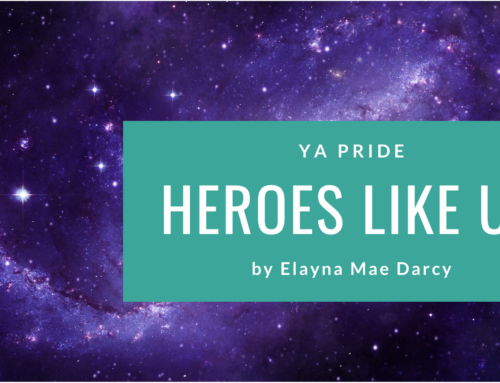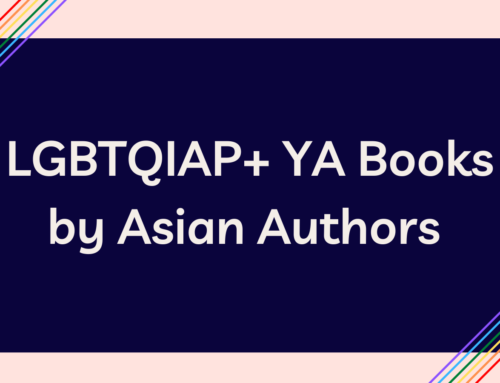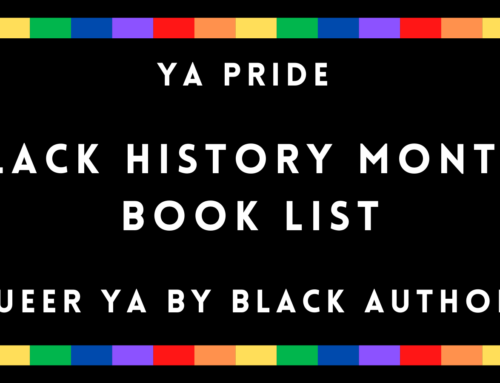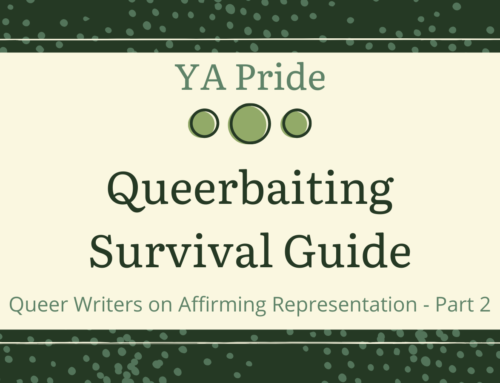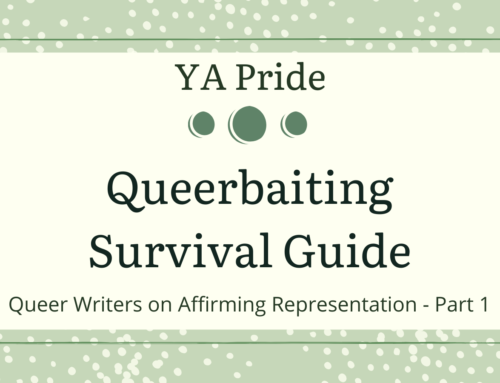by Amanda MacGregor
I’ve worked in the book field for 16 years. I’ve worked as the children’s lead bookseller at Barnes & Noble; at The Children’s Book Shop, an independent bookstore in Brookline, Massachusetts; as a children’s librarian; in a high school library; and as a librarian in a public library. I’ve been reviewing YA books professionally for almost as long (and my list of places I’ve worked for is nearly as long—The Horn Book, SLJ, VOYA, the long-defunct KLIATT, & Children’s Literature). I recently left my library gig, as we’re moving, but while there also spent 4 years running a young adult book club. You can also find me at Teen Librarian Toolbox where I mainly write reviews, focusing heavily on LGBTQIA+ YA books.
So why tell you all that? Because in all of those jobs, over all of those years, one of my main objectives has been to promote LGBTQIA+ YA books and help them get into the hands of all teens, but especially teens who really need them. Whether that meant requesting them as a reviewer, displaying them, booktalking them, including them on reading lists, being seen reading them, or choosing to highlight them, making them visible and emphasizing their importance has always been my goal. I talked about this a little in the May 2014 School Library Journal article, “LGBTQ & You: How to Support Your Students.” I wanted to elaborate a little bit on some of the ways librarians (and booksellers and teachers) can help these books reach queer kids and what else supporting teenagers means.
Some ways you can highlight LGBTQIA+ YA books are:
Booktalks: At the high school, I did booktalks once a semester for the language arts classes. I made sure to include titles that represented many groups and specifically would say, “This book has a gay main character.” I would tell the classes that books with queer characters were one of my main areas of interest and that it was important to support queer kids. I also often reminded kids that I was there to make sure they were reading, not judge what they were reading.
 Displays: Many of my displays were for LGBTQIA+ specific days/months, like LGBT History Month, or National Coming Out Day. In addition to signage that clearly indicated what the display was for, I would include reading lists that kids could take and would leave them out by the computer that was available for them to search the catalog, so they could grab them in semi-privacy if they needed to. I listed resources at the bottom of those lists, like help lines or a reminder that the school had a GSA. I would also put some part of the display on the desk where I worked—maybe statistics, or a featured book, or more information. I spent a lot of my days with kids draped all over my desk, just hanging out, and wanted to put materials in front of as many eyes as I could. In addition to creating displays or reading lists specific to LGBTQIA+ events or content, I also made sure all displays always included books with queer kids, whether it was a display featuring new books, or just the books that sat on top of the shelves, or a display about romances, or supernatural stories, or whatever. I wanted to be specific and pointed—making it clear that I was highlighting LGBTQIA+ books and understood their importance—as well as just integrate those books into all other displays and not drag them out for only “special” displays or only show their importance occasionally.
Displays: Many of my displays were for LGBTQIA+ specific days/months, like LGBT History Month, or National Coming Out Day. In addition to signage that clearly indicated what the display was for, I would include reading lists that kids could take and would leave them out by the computer that was available for them to search the catalog, so they could grab them in semi-privacy if they needed to. I listed resources at the bottom of those lists, like help lines or a reminder that the school had a GSA. I would also put some part of the display on the desk where I worked—maybe statistics, or a featured book, or more information. I spent a lot of my days with kids draped all over my desk, just hanging out, and wanted to put materials in front of as many eyes as I could. In addition to creating displays or reading lists specific to LGBTQIA+ events or content, I also made sure all displays always included books with queer kids, whether it was a display featuring new books, or just the books that sat on top of the shelves, or a display about romances, or supernatural stories, or whatever. I wanted to be specific and pointed—making it clear that I was highlighting LGBTQIA+ books and understood their importance—as well as just integrate those books into all other displays and not drag them out for only “special” displays or only show their importance occasionally.
Reading lists: While at the high school, I made a collection of 12 binders with reading lists in them. They were arranged by genre or theme—science fiction, multicultural, sports, etc.—and updated continually. They featured the title, book cover, summary, and call number. I also put sheets at the end with just titles and authors so kids could grab them to keep. I did have one binder specific to LGBTQIA+ YA, but of course made sure all of those same titles were also folded into the other binders’ reading lists, too. For the most part, after time, the students got comfortable asking me for recommendations, but I wanted to make sure there were plenty of resources for students who didn’t want to come up and ask for help.
Be seen reading LGBTQIA+ YA: I didn’t get a lot of time to read at the desk, but when I did, I tried to make a point with what I was reading. I’d read books with Muslim characters on the cover hoping the Somali kids would see this and discover the books and/or want to talk. I’d read books about queer kids hoping teenagers remembered I’d booktalked it or recognized the title/author enough to know the content. And I’d read Ellen Hopkins books hoping kids would see that I liked those books too and that it was okay to check them out from me instead of constantly stealing them. I also tried to bring up what I was reading while checking out books to a kid, especially if I knew that that particular kid maybe could benefit from knowing about the book.
Some other things you could do: You can connect with your school’s gay-straight alliance—maybe go in and do some booktalks, or partner with them for some displays, or even just have their advisor know that you’re supportive and a good resource. You can remember to recommend LGBTQIA+ YA titles no matter what the request is; that’s to say, sure you’ll recommend them if someone comes in specifically looking for one of those books, but remember if they want a sports story or a romance or a fantasy story to grab books with LGBTQIA+ characters, too. You can make sure your collection includes as many books with queer characters as possible. Despite a huge increase in numbers, there still aren’t a ton of books with queer characters, so be sure to be aware of what’s available and order it in. You can post the results of GLSEN’s School Climate Survey where kids can read it. You can make sure you call out kids who toss around hateful terms while in the library (or your classroom etc.). Do teachers in your school have Safe Space stickers up on their doors? Make sure they know you’re working to support these kids from the library side of things. Also, remember that kids talk. They’ll share these books with others who need them. They’ll pass along the word that you’re an ally, that you know how to help them find the stories they may be seeking.
What else can you do? Educate yourself. Listen. Learn. Be aware of the messages the stories send—is your LGBTQIA+ collection outdated and full of tragedies? Learn the correct language. Pay attention to your students’ preferred names and pronouns and respect that. Also, spend a little time thinking about what you’ll want to say in various scenarios. If you make it clear that you’re an ally, if you start to make connections with kids, your conversations WILL go beyond talking about books. I’ve had kids come out to me before they told anyone else. I’ve had kids tell me they came out to their parents and were told they would go to hell. Or were kicked out. Or told me they were miserable and suicidal. On the flip side, I had kids who would come running in to tell me about finally kissing a girl, or about their parents being totally cool and supportive, or about taking part in Pride events. Some of those conversations are more sensitive than others. Some of those conversations may be the very first time a kid is saying some of these words aloud. What you say matters. How you react matters. Those of us who work with teenagers know that our jobs go beyond what you might expect out of a teacher or a librarian. So knowing what books are out there is important, and doing everything you can to make sure those books are available to kids who need them is important, and showing teenagers that you see them, respect them, and care about them is so important. There are so many small ways we can make libraries safe spaces and provide access to these LGBTQIA+ books, and those small ways can have a big impact.
—
 Amanda MacGregor spends all of her time thinking about, talking about, and writing about YA books as a reviewer, librarian, and blogger at Teen Librarian Toolbox. She lives just outside of St. Paul, Minnesota. Find her on Twitter @CiteSomething.
Amanda MacGregor spends all of her time thinking about, talking about, and writing about YA books as a reviewer, librarian, and blogger at Teen Librarian Toolbox. She lives just outside of St. Paul, Minnesota. Find her on Twitter @CiteSomething.